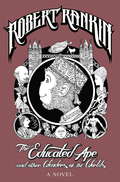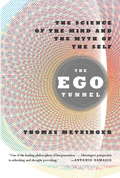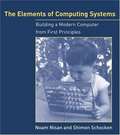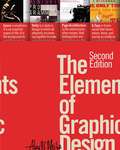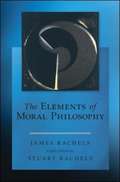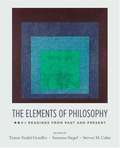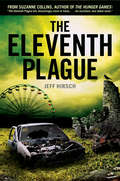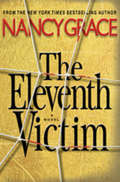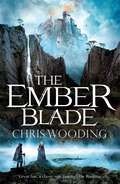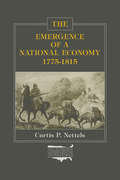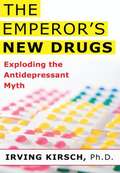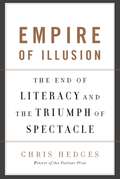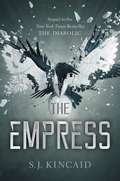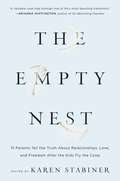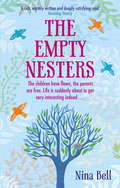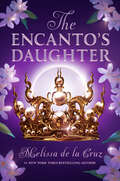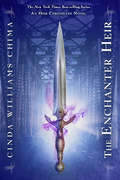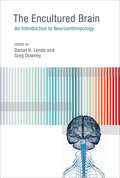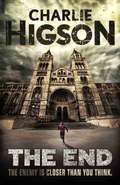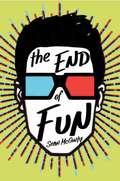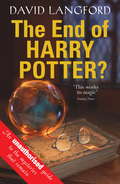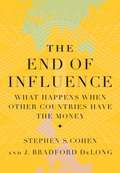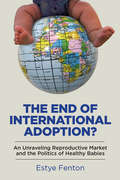- Table View
- List View
The Educated Ape and Other Wonders of the Worlds: A Novel
by Robert RankinAn epic in four movements, this is the third book in Robert Rankin's highly acclaimed meta-Victorian series. Comparable to Pratchett or Douglas Adams, the Father of Far Fetched Fiction has pulled out all of the stops with this riotous tale of wicked women, a dangerous detective and Darwin the educated ape.Lord Brentford has a dream. To create a Grand Exposition that will showcase The Wonders of the Worlds and encourage peace between the inhabited planets of Venus, Jupiter and Earth. Ernest Rutherford has a dream. To construct a time ship, powered by the large hadron collider he has built beneath the streets of London. Cameron Bell is England's greatest detective and he, too, has a dream. To solve the crime of the century before it takes place, without blowing up any more of London's landmarks. Darwin is a monkey butler and he also has a dream. To end Man's inhumanity to Monkey and bring a little joy into the world. Lavinia Dharkstorrm has a dream of her own. Although hers is more of a nightmare. To erase Man and Monkey alike from the face of the Earth and to hasten in the End of Days. Then there is the crime-fighting superlady, all those chickens from the past and the unwelcome arrival of The Antichrist. Things are looking rather grim on planet Earth.
The Ego Tunnel: The Science of the Mind and the Myth of the Self
by Thomas MetzingerWe’re used to thinking about the self as an independent entity, something that we either have or are. InThe Ego Tunnel, philosopher Thomas Metzinger claims otherwise: No such thing as aselfexists. The conscious self is the content of a model created by our brain-an internal image, but one we cannot experienceasan image. Everything we experience is "a virtual self in a virtual reality. ” But if the self is not "real,” why and how did it evolve? How does the brain construct it? Do we still have souls, free will, personal autonomy, or moral accountability? In a time when the science of cognition is becoming as controversial as evolution,The Ego Tunnelprovides a stunningly original take on the mystery of the mind.
The Elegant Essay (Third Edition)
by Lesha MyersThis student book vividly portrays the art of writing elegant essay. The Appendix includes Teaching Models, Grading Sheets, and IEW Essay Model & Style Techniques.
The Elements of Alternate Style: Essays on Writing and Revision
by Wendy BishopElements of Alternate Style contributes to a better understanding of the writing process in general and the stylistic options available to every serious writer. It demonstrates how by teaching alternate and traditional styles in tandem, by focusing on revision as invention, we can help students become newly engaged with their texts-even "school writing. " In this edited collection, successful classroom instructors explore and apply these ideas, drawing from composition pedagogy, creative writing technique, and critical theory. The six essays in Part I delineate an initial classroom sequence. . The authors ask writers to try writing exercises and to reconsider how they have constructed essays in the past-how they might reconstruct them today by looking and looking again, by fracturing and creating double voices, by reconsidering the place of research. Part II pushes these explorations further in five essays that contend that writing is about taking risks, trying (sometimes failing), learning from exploration, from play, from radical twists and turns. Part III engages even broader issues of identity, technology, correctness, and editing. Elements of Alternate Style is a powerful, liberating resource that validates innovative writing instruction and offers a rich array of voices and techniques.
The Elements of Computing Systems: Building a Modern Computer from First Principles
by Noam Nisan Shimon SchockenIn the early days of computer science, the interactions of hardware, software, compilers, and operating system were simple enough to allow students to see an overall picture of how computers worked. With the increasing complexity of computer technology and the resulting specialization of knowledge, such clarity is often lost. Unlike other texts that cover only one aspect of the field, The Elements of Computing Systems gives students an integrated and rigorous picture of applied computer science, as its comes to play in the construction of a simple yet powerful computer system. Indeed, the best way to understand how computers work is to build one from scratch, and this textbook leads students through twelve chapters and projects that gradually build a basic hardware platform and a modern software hierarchy from the ground up. In the process, the students gain hands-on knowledge of hardware architecture, operating systems, programming languages, compilers, data structures, algorithms, and software engineering. Using this constructive approach, the book exposes a significant body of computer science knowledge and demonstrates how theoretical and applied techniques taught in other courses fit into the overall picture. Designed to support one- or two-semester courses, the book is based on an abstraction-implementation paradigm; each chapter presents a key hardware or software abstraction, a proposed implementation that makes it concrete, and an actual project. The emerging computer system can be built by following the chapters, although this is only one option, since the projects are self-contained and can be done or skipped in any order. All the computer science knowledge necessary for completing the projects is embedded in the book, the only pre-requisite being a programming experience. The book's web site provides all tools and materials necessary to build all the hardware and software systems described in the text, including two hundred test programs for the twelve projects. The projects and systems can be modified to meet various teaching needs, and all the supplied software is open-source.
The Elements of Graphic Design: Space, Unity, Page Architecture, and Type (2nd Edition)
by Alex W. WhiteThis pioneering work has been wholly revised and expanded to feature a new dimension of inspiring and counter-intuitive ideas to thinking about graphic design relationships and provides designers, art directors, and students--regardless of experience--with a unique approach to successful design. The second edition includes a new section on Web design; new discussions of modularity, framing, motion and time, rules of randomness, and numerous quotes supported by images and biographies.
The Elements of Moral Philosophy 8th Edition
by Stuart Rachels James RachelsThe Elements of Moral Philosophy by James Rachels and Stuart Rachels is a best-selling text for undergraduate courses in ethics. Thirteen thought-provoking chapters introduce readers to major moral concepts and theories in philosophy through clear, understandable explanations and compelling discussions.
The Elements of Philosophy: Readings from Past and Present
by Steven M. Cahn Susanna Siegel Tamar Szabó GendlerThe Elements of Philosophy: Readings from Past and Present offers an extensive collection of classic and contemporary readings, organized topically into five main sections: Religion and Belief, Moral and Political Philosophy, Metaphysics and Epistemology, Philosophy of Mind and Language, and Life and Death. Within these broad areas, readings are arranged in clusters that address both traditional issues--such as the existence of God, justice and the state, knowledge and skepticism, and free will--and contemporary topics--including God and science, just war theory, vegetarianism, and time travel. Carefully chosen selections from a wide range of pre-20th-century philosophers are paired with writings from more than fifty leading contemporary philosophers and thinkers. The traditional philosophers represented range from Plato and Aristotle to Immanuel Kant and A. J. Ayer; the contemporary philosophers include Saul Kripke, David Lewis, Thomas Nagel, Derek Parfit, Hilary Putnam, Robert Nozick, Judith Jarvis Thomson, John Rawls, Bernard Williams, and Susan Wolf. Also included are selections from linguist Noam Chomsky, physicist Albert Einstein, and psychologist William James. Edited by a team of scholars who are also highly esteemed instructors, The Elements of Philosophy is uniquely student-friendly. A team of undergraduate philosophy majors played a central role in helping to select topics, choose readings, and identify terms likely to require clarification. In response to their suggestions, the volume includes detailed introductions to each section, explanatory footnotes that define unfamiliar terms and concepts, an extensive glossary, and a guide to further resources. A companion Instructor's Manual, available on CD, offers article summaries, suggested essay questions, reading guides, model handouts, and sample syllabi. One of the most extensive and expansive anthologies available, The Elements of Philosophy is an ideal choice for both general and targeted introductory philosophy courses.
The Eleventh Plague
by Jeff HirschIn an America devastated by war and plague, the only way to survive is to keep moving.In the aftermath of a war, America's landscape has been ravaged and two-thirds of the population left dead from a vicious strain of influenza. Fifteen-year-old Stephen Quinn and his family were among the few that survived and became salvagers, roaming the country in search of material to trade. But when Stephen's grandfather dies and his father falls into a coma after an accident, Stephen finds his way to Settler's Landing, a community that seems too good to be true. Then Stephen meets strong, defiant, mischievous Jenny, who refuses to accept things as they are. And when they play a prank that goes horribly wrong, chaos erupts, and they find themselves in the midst of a battle that will change Settler's Landing--and their lives--forever.
The Eleventh Victim
by Nancy GraceThe Eleventh Victim, from former prosecutor Nancy Grace, is a tense thriller depicting a battle of wits between a lawyer, a serial killer, and the NYPD As a young psychology student, Hailey Dean's world explodes when Will, her fiancé, is murdered just weeks before their wedding. Reeling, she fights back the only way she knows how: In court, prosecuting violent crime...putting away the bad guys one rapist, doper, and killer at a time. But dedicating her life to justice takes a toll after years of trials and the endless tide of victims calling out from crime scene photos and autopsy tables. Just as she grows truly weary, a serial killer unlike any other she's encountered begins to stalk the city of Atlanta, targeting young prostitutes, each horrific murder bearing his own unique mark. This courtroom battle will be her last. Hailey heads for Manhattan to pick up the pieces of the life she had before Will's murder, training as a therapist. In a vibrant new world, she finally leaves her ghosts behind. But then her own clients are brutally murdered, one by one, by a copycat using the same M.O. as the Atlanta killer she hunted down years before. Hailey's own DNA is found at the crime scenes. As the body count rises across Manhattan, Hailey is forced to match wits not only with a killer, but with the famed NYPD. Unless she returns to her former life and solves the case, still more innocent people will die at the hands of a killer who plans to get her before she can get him!
The Ember Blade (The\darkwater Legacy Ser.)
by Chris WoodingA land under occupation. A legendary sword. A young man's journey to find his destiny.Aren has lived by the rules all his life. He's never questioned it; that's just the way things are. But then his father is executed for treason, and he and his best friend Cade are thrown into a prison mine, doomed to work until they drop. Unless they can somehow break free . . .But what lies beyond the prison walls is more terrifying still. Rescued by a man who hates him yet is oath-bound to protect him, pursued by inhuman forces, Aren slowly accepts that everything he knew about his world was a lie. The rules are not there to protect him, or his people, but to enslave them. A revolution is brewing, and Aren is being drawn into it, whether he likes it or not.The key to the revolution is the Ember Blade. The sword of kings, the Excalibur of his people. Only with the Ember Blade in hand can their people be inspired to rise up . . . but it's locked in an impenetrable vault in the most heavily guarded fortress in the land.All they have to do now is steal it . . .
The Emergence of a National Economy, 1775-1815
by Curtis P. NettelsPart of a series of detailed reference manuals on American economic history, this volume traces the development of agriculture, transportation, labour movements and the factory system, foreign and domestic commerce, technology and the ramifications of slavery.
The Emperor's New Drugs: Exploding the Antidepressant Myth
by Irving KirschDo antidepressants work? Of course--everyone knows it. Like his colleagues, Irving Kirsch, a researcher and clinical psychologist, for years referred patients to psychiatrists to have their depression treated with drugs before deciding to investigate for himself just how effective the drugs actually were. Over the course of the past fifteen years, however, Kirsch’s research--a thorough analysis of decades of Food and Drug Administration data--has demonstrated that what everyone knew about antidepressants was wrong. Instead of treating depression with drugs, we’ve been treating it with suggestion. The Emperor’s New Drugs makes an overwhelming case that what had seemed a cornerstone of psychiatric treatment is little more than a faulty consensus. But Kirsch does more than just criticize: he offers a path society can follow so that we stop popping pills and start proper treatment for depression.
The Empire of Illusion: The End of Literacy and the Triumph of Spectacle
by Chris HedgesWe now live in two Americas. One-now the minority-functions in a print-based, literate world that can cope with complexity and can separate illusion from truth. The other-the majority-is retreating from a reality-based world into one of false certainty and magic. To this majority-which crosses social class lines, though the poor are overwhelmingly affected-presidential debate and political rhetoric is pitched at a sixth-grade reading level. In this "other America," serious film and theater, as well as newspapers and books, are being pushed to the margins of society.In the tradition of Christopher Lasch's The Culture of Narcissism and Neil Postman's Amusing Ourselves to Death, Pulitzer Prize-winner Chris Hedges navigates this culture-attending WWF contests, the Adult Video News Awards in Las Vegas, and Ivy League graduation ceremonies-to expose an age of terrifying decline and heightened self-delusion.
The Empress: The Diabolic; The Empress; The Nemesis (The Diabolic #2)
by S. J. KincaidThe thrilling sequel to S.J. Kincaid&’s New York Times bestselling novel, The Diabolic, which TeenVogue.com called &“the perfect kind of high-pressure adventure.&”It&’s a new day in the Empire. Tyrus has ascended to the throne with Nemesis by his side and now they can find a new way forward—one where they don&’t have to hide or scheme or kill. One where creatures like Nemesis will be given worth and recognition, where science and information can be shared with everyone and not just the elite. But having power isn&’t the same thing as keeping it, and change isn&’t always welcome. The ruling class, the Grandiloquy, has held control over planets and systems for centuries—and they are plotting to stop this teenage Emperor and Nemesis, who is considered nothing more than a creature and certainly not worthy of being Empress. Nemesis will protect Tyrus at any cost. He is the love of her life, and they are partners in this new beginning. But she cannot protect him by being the killing machine she once was. She will have to prove the humanity that she&’s found inside herself to the whole Empire—or she and Tyrus may lose more than just the throne. But if proving her humanity means that she and Tyrus must do inhuman things, is the fight worth the cost of winning it?
The Empty Nest: 31 Parents Tell the Truth About Relationships, Love, and Freedom After the Kids Fly the Coop
by Karen StabinerA heartwarming, wry, and often surprising collection of essays about the next rite of passage for Baby Boomers: what happens when the kids leave homeAs the baby boom generation ages -- the oldest are now turning sixty -- many of them are learning to deal with a whole new way of life, after the last child has finally moved out and they are, once again, alone. It's the same milestone their own parents faced, but as with so many other markers, this generation approaches it in a whole new way.In this fascinating collection, journalist Karen Stabiner has assembled essays from thirty-one writers, including well-known authors such as Anna Quindlen, Ellen Goodman, and Susan Shreve, about their own experience with the empty nest. Parents whose children left home last week join those with grandchildren to explore how life changes once the offspring leave (unless, of course, they move back in again later). They represent the full range of experience -- from traditional nuclear families to single parents to gay parents to grandparents -- with humor, grace, and poignancy.
The Empty Nesters
by Nina BellClover Jones and Laura Dangerfield have been best friends since their children were born. Along with Clover's stylish, powerful friend, Alice, they share holidays, sleepovers, school runs and childcare. They're like one big family.But all families have their secrets. When the children leave home, Clover and Laura's lives and marriages change forever, and the old rules on love and loyalty no longer apply. And when Alice decides she wants what they've got, Clover and Laura have to find out who they really are. Without the children, can their marriages - and friendship - survive?
The Encanto's Daughter (The Encanto's Daughter #1)
by Melissa de la CruzA young woman claims the throne of a realm inspired by Filipino mythology in this YA romantic fantasy, the first in an enchanting new duet by #1 New York Times bestselling author Melissa de la Cruz.MJ Rodriguez has spent her life hiding in the human world, keeping a heavy secret: She&’s half-encanto. As the only child of King Vivencio of the Sirena Court, she&’s also next in line for the throne. And now, upon her estranged father&’s sudden death, MJ must claim her place as rightful heir.In wondrous Biringan, the road to the throne is paved with thorns. Without a reigning monarch, the realm has spiraled into disarray. MJ has to win over a backstabbing council that objects to a half-human ruler. And when it looks like her father&’s passing wasn&’t natural but possibly inflicted by a curse, she must hunt down the sorceress behind this merciless magic.In a bind, MJ forges an unlikely alliance with the striking Sir Lucas of the feared Sigbin Court, and soon, she loses her heart to the mysterious knight. But with peril looming over Biringan, the princess must decide if she can both open herself to love and carry the weight of the crown.
The Enchanter Heir (The Heir Chronicles #4)
by Cinda Williams ChimaThe long-awaited return to the world of the beloved and New York Times best-selling Heir Chronicles seriesThey called it the Thorn Hill Massacre-the brutal attack on a once-thriving Weir community. Though Jonah Kinlock lived through it, he did not emerge unscathed: like the other survivors Jonah possesses unique magical gifts that set him apart from members of the mainline guilds. At seventeen, Jonah has become the deadliest assassin in Nightshade, a network that hunts the undead.Emma Claire Greenwood grew up worlds away, raised by a grandfather who taught her music rather than magic. An unschooled wild child, she runs the streets until the night she finds her grandfather dying, gripping a note warning Emma that she might be in danger. The clue he leaves behind leads Emma into Jonah's life-and a shared legacy of secrets and lingering questions.Was Thorn Hill really a peaceful commune? Or was it, as the Wizard Guild claims, a hotbed of underguild terrorists? The Wizards' suspicions grow when members of the mainline guilds start turning up dead. They blame Nightshade, bringing tensions between the groups to a head.Racing against time, Jonah and Emma work to uncover the truth about Thorn Hill, amid increasing concern that whoever planned the Thorn Hill Massacre might strike again.
The Encultured Brain: An Introduction to Neuroanthropology
by Daniel H. Lende Greg DowneyBasic concepts and case studies from an emerging field that investigates human capacities and pathologies at the intersection of brain and culture. The brain and the nervous system are our most cultural organs. Our nervous system is especially immature at birth, our brain disproportionately small in relation to its adult size and open to cultural sculpting at multiple levels. Recognizing this, the new field of neuroanthropology places the brain at the center of discussions about human nature and culture. Anthropology offers brain science more robust accounts of enculturation to explain observable difference in brain function; neuroscience offers anthropology evidence of neuroplasticity's role in social and cultural dynamics. This book provides a foundational text for neuroanthropology, offering basic concepts and case studies at the intersection of brain and culture.After an overview of the field and background information on recent research in biology, a series of case studies demonstrate neuroanthropology in practice. Contributors first focus on capabilities and skills—including memory in medical practice, skill acquisition in martial arts, and the role of humor in coping with breast cancer treatment and recovery—then report on problems and pathologies that range from post-traumatic stress disorder among veterans to smoking as a part of college social life.Contributors Mauro C. Balieiro, Kathryn Bouskill, Rachel S. Brezis, Benjamin Campbell, Greg Downey, José Ernesto dos Santos, William W. Dressler, Erin P. Finley, Agustín Fuentes, M. Cameron Hay, Daniel H. Lende, Katherine C. MacKinnon, Katja Pettinen, Peter G. Stromberg
The End of Fun (An Enemy Novel #7)
by Charlie HigsonEveryday Reality is a Drag?.FUN¿-the latest in augmented reality-is fun but it's also frustrating, glitchy, and dangerously addictive . Just when everyone else is getting on, 17-year-old Aaron O'Faolain wants off.But first he has to complete his Application for Termination, and in order to do that he has to deal with his History-not to mention the present, including his grandfather's suicide and a series of clues that may (or may not) lead to buried treasure. As he attempts to unravel the mystery, Aaron is sidetracked again . . . and again. Shadowed by his virtual "best friend," Homie, Aaron struggles with love, loss, dog bites, community theater, wild horses, wildfires, and the fact (deep breath) that actual reality can sometimes surprise you.Sean McGinty's strikingly profound debut unearths a world that is eerily familiar, yet utterly original. Discover what it means to come to the end of fun.
The End of Fun (An Enemy Novel #7)
by Sean McGintyEveryday Reality is a Drag?.FUN¿-the latest in augmented reality-is fun but it's also frustrating, glitchy, and dangerously addictive . Just when everyone else is getting on, 17-year-old Aaron O'Faolain wants off.But first he has to complete his Application for Termination, and in order to do that he has to deal with his History-not to mention the present, including his grandfather's suicide and a series of clues that may (or may not) lead to buried treasure. As he attempts to unravel the mystery, Aaron is sidetracked again . . . and again. Shadowed by his virtual "best friend," Homie, Aaron struggles with love, loss, dog bites, community theater, wild horses, wildfires, and the fact (deep breath) that actual reality can sometimes surprise you.Sean McGinty's strikingly profound debut unearths a world that is eerily familiar, yet utterly original. Discover what it means to come to the end of fun.
The End of Harry Potter?
by David LangfordTHE END OF HARRY POTTER is the perfect companion volume for all Harry Potter fans. Award-winning writer and Potter fan David Langford delves into the six Harry Potter books to explore J.K. Rowling's universe and characters, and shows in detail how cleverly J.K. Rowling has woven her world.This is the book for you if you are one of the gazillions of readers who find themselves wondering about horcruxes and Deatheaters and Dark Lords ... Langford looks at questions like:*What are the remaining horcruxes, the places He Who Shall Not Be Named has stashed his soul so he can never die?*Does Harry himself bear a part of the Dark Lord's soul in his scar?*Is that why Harry understands Parseltongue - and if not, why does he speak the language of the serpentssss?*What will happen when Harry is technically a grown-up, and no longer under the protection of his Uncle Vernon and Aunt Petunia?*Is Albus Dumbledore really dead?*Whose side is Severus Snape really on?*Will Hogwarts survive the final, apocalyptic battle between Harry and You-Know-Who?Don't know the answers? Then read THE END OF HARRY POTTER!
The End of Influence: What Happens When Other Countries Have the Money
by Stephen Cohen J. Brandford DelongNow that the US is not the worldOCOs biggest banker, its future as a superpower is looking shaky.
The End of International Adoption?: An Unraveling Reproductive Market and the Politics of Healthy Babies (Families in Focus)
by Estye FentonSince 2004, the number of international adoptions in the United States has declined by more than seventy percent. In The End of International Adoption? Estye Fenton studies parents in the United States who adopted internationally in the past decade during this shift. She investigates the experiences of a cohort of adoptive mothers who were forced to negotiate their desire to be parents in the context of a growing societal awareness of international adoption as a flawed reproductive marketplace. Many parents, activists, and scholars have questioned whether the inequality inherent in international adoption renders the entire system suspect. In the face of such concerns, international adoption has not only become more difficult, but also more politically and ethically fraught. The mothers interviewed for this book found themselves navigating contemporary American family life in an unexpected way, caught between the double-bind of work-family life and a new paradigm of thinking about the method—international adoption—that they used to create those families.
